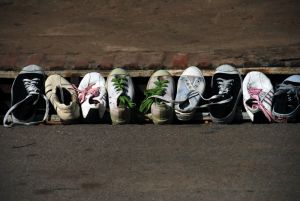Confession: I’m a User and a RE-User.
So, not that many years ago, I was enviro-oblivious.
One of those Americans who doesn’t think of themselves as particularly wasteful, but whose garbage can was always mysteriously refilled as soon as it was emptied.
Then one day I made some changes.
They weren’t anything catastrophic.
I didn’t chain myself to any trees on the chopping block. I have yet to aspire to that sort of vigilante coolness.
Instead, I started looking for things–small things–I could work into my normal rhythm; things that were as easy and routine as brushing my teeth every day; things that would slowly change my habits.
Here are the first five things I ever did to become a little more friendly to the dirt I walk on and air I breathe.
1. I arranged for curbside recycling.
I had seen my in-laws and grandparents, who live in big cities with more expansive recycling programs, kicking their trash to the curb (in a very orderly, sorted manner) for years. But I never saw anyone in my little city trying to pull it off. I figured, in a not-very-progressive city like ours, the extra cost would make a pretty big dent in my budget.
I was wrong.
It cost $2.50 a month to have my existing garbage company pick up my cardboard, glass and plastics picked on the first Friday of the month.
I didn’t even have to change my garbage company. I just called the one I had and asked about what options we had. Had our garbage removal company not had a recycling service, I could’ve called another competitively-priced service, as there were several whose phonebook ads offered recycling options.
2. I started kicking the magazines out of the house when they came of age.
I am a huge reader and my husband is a big sports fan (not a sports addict, mind you) , so suffice to say we have a lot of bathroom reading materials.
One of the things I always loved when visiting my grandparents as a child was that they had stashes of magazines available to peruse throughout the house. I followed suit. I have a small floor magazine rack (its a pleather box more or less) in our bedroom, in both bathrooms, and in the living room. You can’t miss them. People flip through them all the time like they’re browsing at Borders (or Schuler’s if you’re a fan of our Lansing locals). Its wonderful.
But the magazines stack up. Cultural mags, parenting mags, the occasional beauty mag, and now the almost-counter-intuitive-because-they’re-printed-on-paper environmental mags. (Sidenote: I rarely if ever pay more than $5 for a subscription. Just google “$5 magazine subscriptions” and you’ll be on your way!)
Result? We have I-don’t-even-know-how-many-dead-forests in our magazine racks. I figured this could only be acceptable if I sent the old copies away to be chopped up and made into cool stuff like this…
And so that’s what I did. Again, knowing nothing about recycling, I googled “where to recycle” and came up with two options. My first option, when I began, was on the campus of the local community college (JCC) which also housed my workplace (daVinci) at the time. When I transitioned jobs and stopped going to that part of town every day, I moved to the recycling setup at the church where I had previously worked, who had installed recycling bins since I worked there (Westwinds). Now, once every couple months, I scoop up these mags, throw them in a bag and take them to one of these spots.
 3. I began dispensing invaluable knowledge (aka books).
3. I began dispensing invaluable knowledge (aka books).
As a writer and an English teacher, I am a magnet for books.
I buy them. (Someone once told me they would bargain for almost anything, trying to talk people down on prices. Except for books. She said books are knowledge. As long as you can read them, knowledge doesn’t depreciate. Its valuable. So its okay to pay full price, she told me.)
What’s even cooler is people buy them for me. And publishers send them to me to look at, to review.
But eventually you get to the point where even a book-nerd like myself starts to drown in the piles.
So I keep the ones that have been meaningful to my journey.
And I give away relevant titles to friends.
But then I donate the rest.
I used to donate them to the school where I worked, where they could use extra paper backs for DEAR time (Drop Everything and Read Time). Schools, local juvenile programs, even correctional facilities will often take books. And speaking as the Skinny White Girl who lives in Prison City and works with many youth who have been confined in these facilities, they say they never appreciated books as much as when they were locked up. (If only I had some prison cells in my classroom…) So especially if you have a book with a positive message, there’s an option that keeps on giving.
I also use the Book Exchange in our town. Ours is literally called the Book Exchange. The idea is you bring in old books and they give you a “credit” (a mark on a piece of paper) for each one. Then if you ever want a book (and they have almost every popular title you can think of, as long as its been out a year or longer), you can buy the used version of that book for $2.50-$3.50 (when you apply your credits for discount). Its a nice savings.
I have a former-student-turned-adult who uses paperbackswap.com to trade books for free (or for the cost of shipping). …Shout out to Tai.
4. I put my clothes back to work .
.
Sometimes I buy clothes or am given clothes that purposefully mislead me. They are evil. They look great on the rack. Even more fabulous in the fitting room. But ridiculous in real life, once I walk outside the store’s double doors (laden with big yellow clearance signs, I might add). These clothes I pack up and take to the Clothing Carousel on Franklin St. Its a resale shop.
I once met a lady that said her contribution to the environment was that she was never going to wear new clothes. She had plenty of money to purchase new items, but consciously decided not to. “There are so many clothes out there already.” She said, “Why would I need people to make more for me?”
A lot of people who shop at resale shops are also in a financial position where they need heavily discounted merchandise.
When you drop off clothes to a resale shop, they must be in good condition (not worn out, frayed, stained etc.) and in season. Every couple months I stop in to check out my “balance”–40% of whatever my items sold for. And the rest, whatever they don’t sell within six months, is donated to the charity of my choice (they even take care of the pick up).
5. I got ruthless toward clutter. Its just not welcome here.
I sort it into piles. This stuff is appropriate for the homeless shelter (Interfaith); this stuff for the domestic violence shelter (Aware). There’s also the Salvation Army, the resale shop that benefits a local private school, and of course the very good Good Will where my buddy Evan gets to sort through all the donations.
When those spots don’t work out, I head to freecycle.org where you can post an ad about any random item you’re giving away. And people will come and cart it away. Really. They will somehow have the exact perfect use for that afghan that your friend’s grandmother embroidered your anniversay into in hot pink thread.
Also, fyi. There is nothing like a “free” sign on the curb to get rid of anything. My husband and I have put this one to the test and we have yet to find anything that people won’t take away. Amongst the curbside treasures we’ve awarded to others are carpet scraps, bushes we just pulled out of our yard, and a vacuum labeled “broken, but free” (it was gone in under an hour – no lie).
So its true. You too have options other than pack-rat-dom.
Give your stuff away. And some say, since you don’t need it, you should put it back in the world so it can find its “rightful owner” in the person who does need it.


Joanna March 8, 2010 (5:43 pm)
Another really good way to be environmentally friendly without having to try too hard is to instead of buying bottled water, refill a reusable bottle from the tap. The cost of buying bottled water can easily add up and what goes into making the bottle, filling it, and then shipping the full bottle to you is not good at all for the environment.